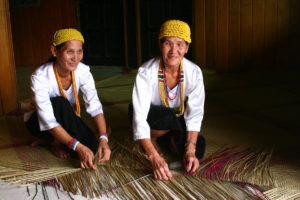
The indigenous people of Sarawak, located on the west coast of the great island of Borneo, have always found most of the necessities of life in the forest around them: wood for building houses and boats, and reeds, creepers and leaves for making mats, baskets and hats.

In the past, the “furniture” of a longhouse family room consisted almost entirely of mats for sitting and sleeping on and baskets for storage, transport and ritual purposes. Garments were made of homespun cotton, but hats were plaited or stitched of finely split rattan, bemban or palm leaves.
The common sleeping and wrapping mat is plaited of screwpine or pandan leaves (Pandnaus odoratissimus), which is comfortable and soft, but not very durable. The smooth skin of bemban canes (Donax arundastrum) is worked into a finer, stronger material with self-coloured motifs. The most durable mats, woven of split rattan (Calamus spp.) and bark fibre (Artocarpus elasticus), are usually very large and are used for covering and strengthening the floor of the longhouse during festivals when crowds are expected.
Basketry and mats are worked in two distinctive techniques: diagonal interlacing (x) and horizontal–vertical interlacing (+). The latter technique is mainly used by the Bidayuh of west Sarawak and the Lun Bawang/Kelabit of the eastern highlands. In the last 50 years or so, better communications and interaction among the peoples of Sarawak have encouraged the borrowing and copying of craft styles and techniques.
Semi-rigid fibre plaiting on the bias is commonly done by the Iban, Melanau and related groups, who have achieved a high level of artistry in working decorations into their mats, baskets and hats.
The twentieth century has brought foam rubber mattresses and “plastic for everything” into the villages and longhouses of Sarawak. Colourful, tough plastic packing strips are used to make “basketry” as these are easily available, while good rattan is getting very hard to find and is expensive.
Mats and basketry may be seen at the Kraftangan and Sarawak Craft Council showrooms and in many souvenir shops.






